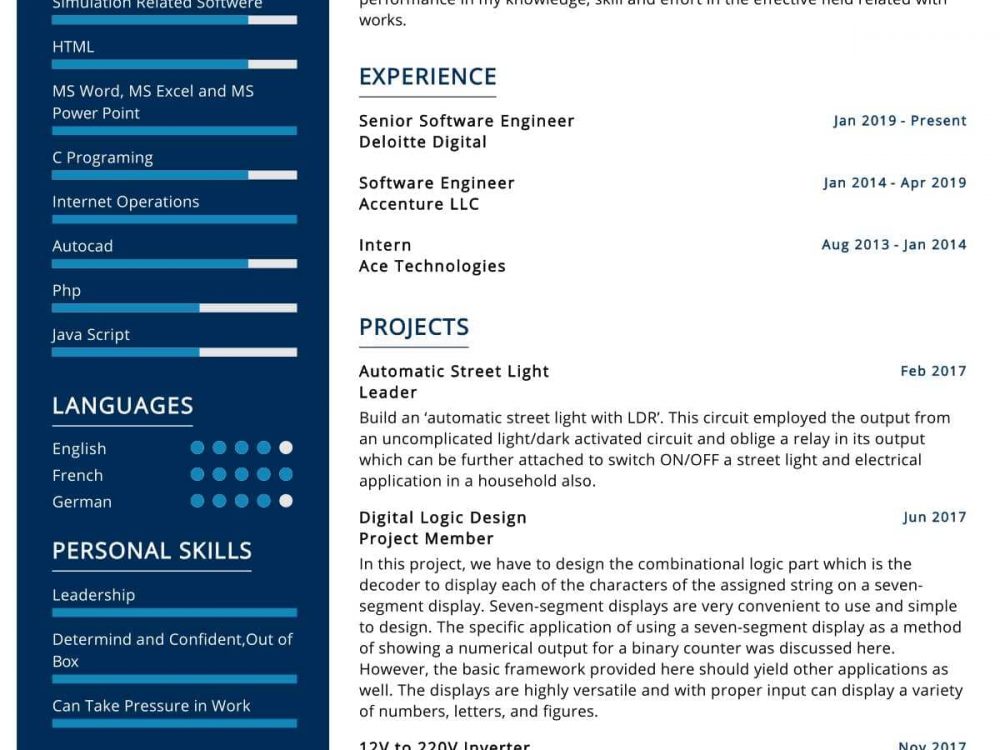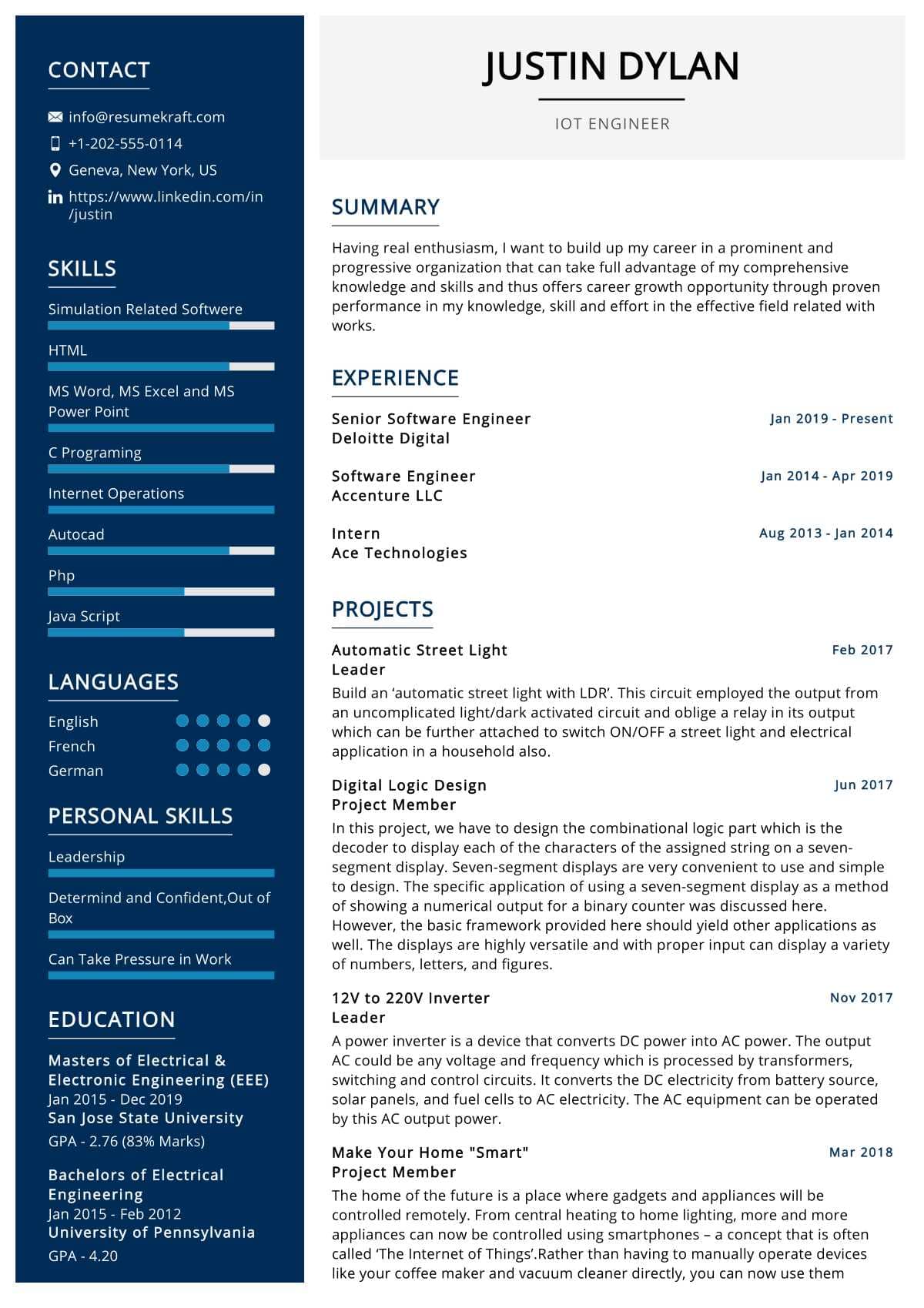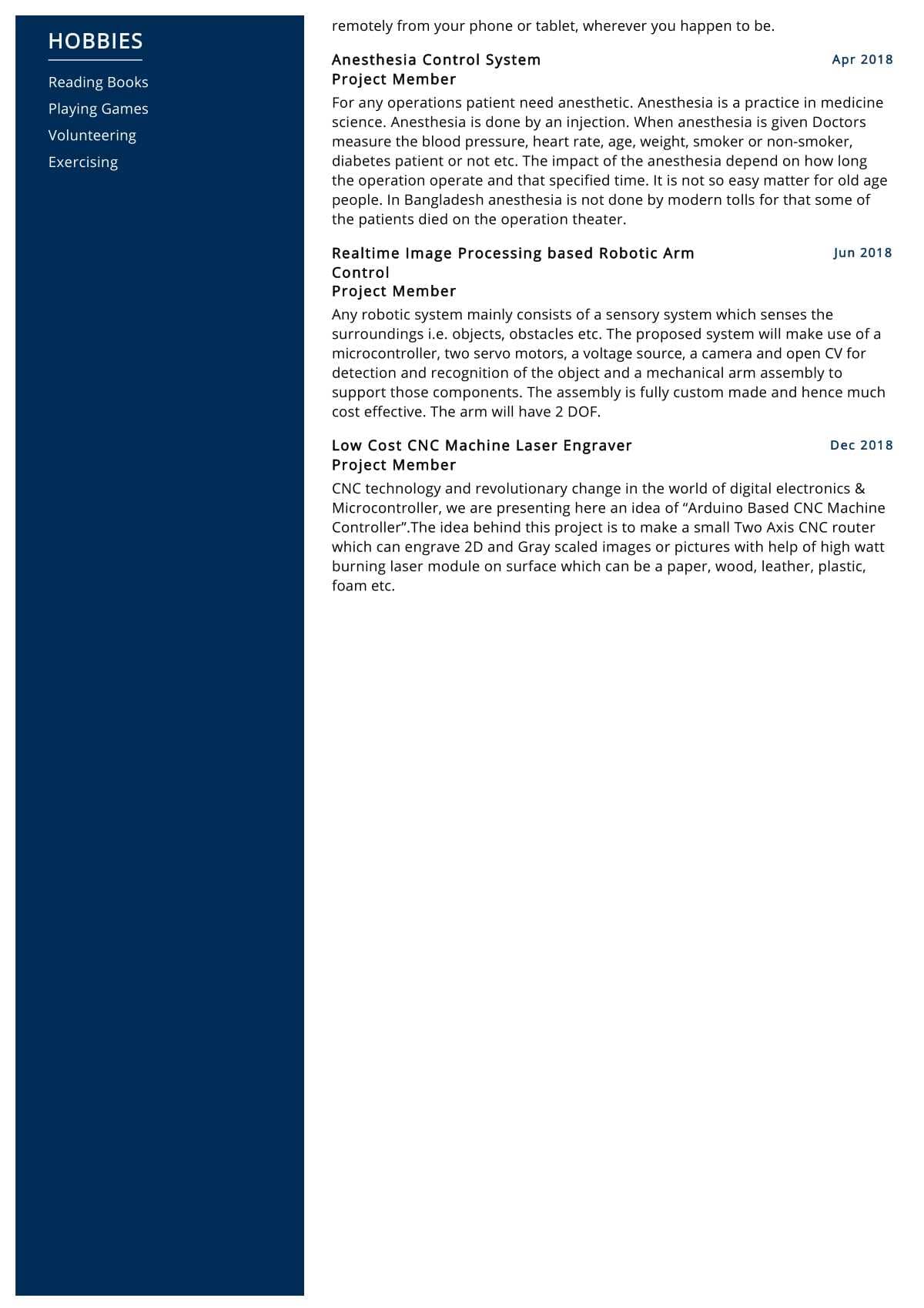Are you an IoT Engineer by profession and looking for an exciting career? We have good news for you! use our professional IoT Engineer Resume Sample. You don’t have to start writing from scratch. Just click “Edit Resume” and modify it with your details. Update the template fonts and colors have the best chance of landing your dream job. Find more resume samples.
IoT Engineer Resume Sample
Justin
IoT Engineer
Summary
Having real enthusiasm, I want to build up my career in a prominent and progressive organization that can take full advantage of my comprehensive knowledge and skills and thus offers career growth opportunities through proven performance in my knowledge, skill, and effort in the effective field related to works.
Skills
Work Experience
Senior Software Engineer
Deloitte Digital
Software Engineer
Accenture LLC
Intern
Ace Technologies
Projects
Automatic Street Light
Leader
Build an ‘automatic street light with LDR’. This circuit employed the output from an uncomplicated light/dark activated circuit and oblige a relay in its output which can be further attached to switch ON/OFF a street light and electrical application in a household also.
Digital Logic Design
Project Member
In this project, we have to design the combinational logic part which is the decoder to display each of the characters of the assigned string on a seven-segment display. Seven-segment displays are very convenient to use and simple to design. The specific application of using a seven-segment display as a method of showing a numerical output for a binary counter was discussed here. However, the basic framework provided here should yield other applications as well. The displays are highly versatile and with proper input can display a variety of numbers, letters, and figures.
12V to 220V Inverter
Leader
A power inverter is a device that converts DC power into AC power. The output AC could be any voltage and frequency which is processed by transformers, switching and control circuits. It converts the DC electricity from battery source, solar panels, and fuel cells to AC electricity. The AC equipment can be operated by this AC output power.
Make Your Home “Smart”
Project Member
The home of the future is a place where gadgets and appliances will be controlled remotely. From central heating to home lighting, more and more appliances can now be controlled using smartphones – a concept that is often called ‘The Internet of Things’.Rather than having to manually operate devices like your coffee maker and vacuum cleaner directly, you can now use them remotely from your phone or tablet, wherever you happen to be.
Anesthesia Control System
Project Member
For any operations patient need anesthetic. Anesthesia is a practice in medicine science. Anesthesia is done by an injection. When anesthesia is given Doctors measure the blood pressure, heart rate, age, weight, smoker or non-smoker, diabetes patient or not etc. The impact of the anesthesia depend on how long the operation operate and that specified time. It is not so easy to matter for old age people. In Bangladesh anesthesia is not done by modern tolls for that some of the patients died on the operation theater.
Realtime Image Processing based Robotic Arm Control
Project Member
Any robotic system mainly consists of a sensory system that senses the surroundings i.e. objects, obstacles etc. The proposed system will make use of a microcontroller, two servo motors, a voltage source, a camera and open CV for detection and recognition of the object, and a mechanical arm assembly to support those components. The assembly is fully custom made and hence much cost-effective. The arm will have 2 DOF.
Low Cost CNC Machine Laser Engraver
Project Member
CNC technology and revolutionary change in the world of digital electronics & Microcontroller, we are presenting here an idea of “Arduino Based CNC Machine Controller”.The idea behind this project is to make a small Two-Axis CNC router that can engrave 2D and Gray scaled images or pictures with help of high watt burning laser module on the surface which can be paper, wood, leather, plastic, foam etc.
Education
Masters of Electrical & Electronic Engineering (EEE)
San Jose State University
Bachelors of Electrical Engineering
University of Pennsylvania
Languages
- French
- English
- German
- Chines
Career Expert Tips:
- Always make sure you choose the perfect resume format to suit your professional experience.
- Ensure that you know how to write a resume in a way that highlights your competencies.
- Check the expert curated popular good CV and resume examples
IoT Engineer Resume with Writing Guide
In today’s modern job market, it is becoming increasingly difficult to secure a job as an IoT engineer. There are multiple aspects to the job, requiring technical skills in computers and engineering along with innumerable other qualifications that make this field a competitive market. One differentiating factor that many employers are looking for when hiring an IoT engineer is your resume.
What can you do to get noticed? You need a well-crafted resume and cover letter that highlights your unique skills and experience. A well-written resume is your first and best opportunity to impress potential employers. Here are the components to an effective IoT engineer resume:
IoT Engineer Resume Objective statement:
What do you want to do in your industry? It should be specific and focused on the skills, experience, and accomplishments that create your value. For entry-level job seekers, it’s important to show an understanding of the IoT while also being able to describe how you would contribute meaningfully as an employee after only a few months on the job. For more experienced workers, it’s important to describe things like the best aspects of your prior employer(s) and how you would improve their IoT system or product.
IoT Engineer Resume Summary:
This section should briefly describe your background and include details of your education, work experience, skills, successes, and achievements. Include a brief explanation of why you are interested in the field in addition to the type of work you hope to do. The summary should be two to five lines long and is often located at the top of the resume after your contact information.
How to Write a Resume for an IoT Engineer:
- Use Keywords from the Job Description to Customize your Resume!
- Tailor each Section of Your Resume Around What They Are Looking For!
- Prove That You’re the Perfect Candidate Through Testimonials and Awards!
- Keep Your Resume Brief and to the point, but No Shorter than 1 Page!
- Make Sure You Also Have a Cover Letter!
- Send a Resume and Cover Letter, not just a resume and cover letter!
- Use the Right Resume Format for Each Industry!
- Most Important- Get Interviews!
- Interviewing Tips You Need to Know!
- Don’t let that job slip through your fingers- follow these steps to land that career opportunity of a lifetime (or at least get another interview)!
List of Typical Responsibilities For an IoT Engineer Resume:
- Evaluate the client’s requirements and make recommendations to implement.
- Select and implement a suitable software or hardware system, such as CRM, ERP, SCADA, etc..
- Identify problems of the existing systems and suggest improvements or modifications.
- Develop specifications for new systems; and plan data mapping from the old to new system..
- Prepare documents for bidding of projects to obtain bids from vendors; review bids to select most advantageous offer; negotiate with vendors over contract terms
- Manage and direct network installation and configuration.
- Manage and direct software applications installation, configuration, troubleshooting, and upgrades.
- Ensure system compatibility for the unification of software applications.
- Monitor and ensure the security of system software as well as hardware.
- Research new technology that would improve existing products or services offered by the company.
- Prepare documentation such as user manuals, training guides, operating instructions, etc.. to ensure effective use of new systems.
Top 10 Must-have IoT Engineer Skills:
- Networking:
A strong grasp of TCP/IP, sub-netting, LANs and WANs is a must. You will be expected to configure and troubleshoot networks, along with configuring routers, firewalls, gateways, and more. - Hardware:
You will have to work on hardware coding such as MCU programming (usually), microcontrollers programming, EMC protection & design, etc. You need to be good with hardware, as it is one of the most important things in IoT. - Software:
You will be responsible for ensuring that your code is run on the right hardware configurations and that you have a proper means of communication setup. You should have a good understanding of software development tools like using UML diagrams to create software structures. - Security:
You will have to code security features into your device or firmware. This includes encryption, authentication mechanisms, and key management. You will be expected to make sure that your code is as secure as possible, and make sure it is hardened against attacks. - Embedded Systems:
You are doing the hard work on embedded systems; you will have to learn about the inner working parts of an integrated circuit. You will be expected to know what microprocessors work on what frequency (generally). You will also have to know microcontrollers (MCUs) well enough to troubleshoot them yourself. - Maintenance:
You will be expected to keep your device or firmware up and running and do the hard work of making sure that the code is functioning properly with very little input from you. You will also have to make sure that you are loading new versions of software as they are released (the “push” model). - RFID:
RFID is an additional skill that each IoT engineer has to learn. RFID is a communication technology whose range is generally at least 10 meters. This is used to connect tags and readers, where the tag in a small tag embedded in the product which communicates with an RFID reader carried by a person or mounted on the shelf or other location. You will have to learn RFID and how it works and also how to code it. - Sensors:
You will be coding sensors in your IoT device, and you will have to make sure that they are able to communicate with the rest of your device. You will need to have a strong understanding of these sensors and the purpose they serve in your device. This includes everything from pressure sensors, accelerometers, magnetometers etc. - Design:
You will also need to learn design principles like proper naming conventions and how to document your code properly for other people to use (If they need to). - Reliability:
The reliability of your IoT device is very important. You will be expected to create a reliable device/firmware, and you will have to ensure that the device does not crash or freeze, and that it does not throw any errors. You will need to make sure everything runs the way that it is supposed to.
Tips to write an IoT Engineer Resume Summary:
- Functional Summary – This is your opportunity to grab the reader’s attention and to make them wish to learn more about your experience. Review the job posting and speak directly to the most important qualifications that are sought. The summary should not exceed 2-4 sentences, so be concise and make sure that all of the main points you want to cover are there.
- Key Accomplishments – In this section, you will want to go into your previous positions in detail and identify your accomplishments within those roles. Do not merely list job titles as it will not impress the reader. Review the job description and highlight your level of contribution and responsibility, rather than just your role. While you may want to include less relevant positions in a chronological resume, this is the perfect opportunity to give those positions some much-needed attention. Highlight examples that clearly demonstrate how you have achieved results or how you have added value through your efforts.
- Education – List education at the top of any resume, since this is typically considered an asset by many employers.
Summary Example:
“Having 5 years of experience as an IoT engineer, I am seeking an opportunity to leverage my extensive knowledge of the latest devices and tools for a position that will allow me to advance my career as a technical consultant with exposure to new challenges on ongoing projects and tasks. Since I am highly motivated and detail-oriented, I believe my interpersonal skills are a perfect fit for the intricate requirements of technology leaders. My educational background includes an Associates Degree in Management Information Systems from Community College XYZ, as well as an industry certification in .NET programming.”
How to write an IoT Engineer Resume with No experience:
- Begin with the standard format for a CV or Resume
- Include key skills such as ‘Python’, ‘Linux’ and ‘Networking’3. Include employment history with your education and describe how you have done things relevant to the job4. Your IoT Engineer Resume should be simple, easy to read and should highlight what you have experienced doing
- Make sure you include a cover letter that describes anything that is unique about you not included in your CV
How to write an IoT Engineer Cover Letter:
- Use Your Resume to Customize Your Cover Letter
- Use Killer Keywords to Impress the Reader
- Don’t just say you’re an expert-prove it!
- Proofread- the impact is huge!
- Step Down From Your High Horse to Make a Great Impression
- Don’t Make These Rookie Mistakes
- Be Persuasive, Not Manipulative!
- Don’t Give Up Your Secret Identity!
- The Internet of Things is the Next Big Thing, and You are at the Center of It!
- Resumes and Cover Letters You Should Be Using!
- A Thank You Note is Key!
How to Write an IoT Resume When you Have No Experience:
- Make sure that you have a resume, not just a cover letter!
- Create a bullet point list about projects you did outside of school, using your own words!
- Be honest- if you don’t work much, don’t put down that you do!
- If you do not have any entry-level experience, try to get as much as possible!
- Show off your skills by writing a cover letter and tailoring it to the job description!
- Don’t give up!
- Get your resume reviewed by people who have the job you’re trying for, even if it’s a friend or family member!
TIPS:
- Use your own words- don’t just copy and paste from somewhere else, and if you do, make sure that you write it in a way that you sound like yourself!
- Tailor your resume to the job description- imagine that they wrote it themselves and adapt accordingly.
- Proofread!
- Show off your skills- don’t just say you’re good at what you do, convince the reader that you’re the BEST!
- Show off your skills, not your resume!
Key Takeaways:
- The resume is your opportunity to establish your credentials.
- Your resume should be a lot more than a collection of your jobs, responsibilities, and achievements.
- Your resume should focus on the specific aspects that you want to highlight in order for potential employers to get to know you further and better understand who you are.
- Focus on needed skills and abilities that will benefit the employer(s) in the roles for which they are hiring right now or in future opportunities.
- An unlimited and free resume writing service is available for you; take advantage of the service and get your resume reviewed by expert resume writers!
- Learn to customize your resume using our guide for additional information on how to personalize your resume, including tips on how to write the perfect engineer resume.
- No matter which industry you are an engineer in, there is a way to describe yourself and highlight the skills that employers are looking for in their next hire, whether it’s a new position or an ongoing one.



